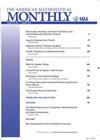一个连续的无处可微函数能否形象化?
IF 0.4
4区 数学
Q4 MATHEMATICS
引用次数: 0
摘要
摘要当学生在实际分析课程中第一次遇到连续无处可微函数的例子时,他们会看到什么?当部分和变得越来越复杂时,很难想象函数的无穷和。我们通过这样一个函数的图提供了一种几何方法。我们的主题是基于这样一个事实,即如果一个函数的图以一种特殊的方式与所有非垂直线相交,那么该函数在任何点都不能有导数。我们将要求,在函数的图G上的每个点P处,必须有许多线L到P,其中P作为交点的极限点。这幅图很容易想象,但不可能用图形表示:它避免了19世纪数学家首次试图描述这些函数时所面临的所有计算复杂性。本文章由计算机程序翻译,如有差异,请以英文原文为准。
Can One Visualize a Continuous Nowhere Differentiable Function?
Abstract When students first encounter an example of a continuous nowhere differentiable function in a real analysis course, what do they visualize? It is not easy to visualize an infinite sum of functions when the partial sums get increasingly complicated. We offer a geometric approach via the graph of such a function. Our theme is based on the fact that, if the graph of a function intersects all non-vertical lines in a special way, then that function cannot have a derivative at any point. We will require that at each point P on the graph G of the function there must be many lines L through P having P as a limit point of the intersection . This picture is easy to imagine but impossible to represent graphically: it avoids all of the computational complications that faced nineteenth-century mathematicians when they first attempted to describe these functions.
求助全文
通过发布文献求助,成功后即可免费获取论文全文。
去求助
来源期刊

American Mathematical Monthly
Mathematics-General Mathematics
CiteScore
0.80
自引率
20.00%
发文量
127
审稿时长
6-12 weeks
期刊介绍:
The Monthly''s readers expect a high standard of exposition; they look for articles that inform, stimulate, challenge, enlighten, and even entertain. Monthly articles are meant to be read, enjoyed, and discussed, rather than just archived. Articles may be expositions of old or new results, historical or biographical essays, speculations or definitive treatments, broad developments, or explorations of a single application. Novelty and generality are far less important than clarity of exposition and broad appeal. Appropriate figures, diagrams, and photographs are encouraged.
Notes are short, sharply focused, and possibly informal. They are often gems that provide a new proof of an old theorem, a novel presentation of a familiar theme, or a lively discussion of a single issue.
Abstracts for articles or notes should entice the prospective reader into exploring the subject of the paper and should make it clear to the reader why this paper is interesting and important. The abstract should highlight the concepts of the paper rather than summarize the mechanics. The abstract is the first impression of the paper, not a technical summary of the paper. Excessive use of notation is discouraged as it can limit the interest of the broad readership of the MAA, and can limit search-ability of the article.
 求助内容:
求助内容: 应助结果提醒方式:
应助结果提醒方式:


